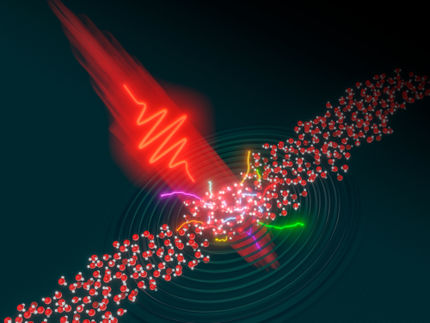Un-mixing using lasers to make new crystals
Scientists have managed to separate two liquids in a mixture using a laser, which they claim will lead to new ways of manipulating matter and creating Crystals for industry.
Researchers from the University of Glasgow present a novel approach to separate and create new phases using a simple laser. The faithful production of crystals is critically important in science and technology as crystals are used in computers, phones, drugs, paints, light bulbs, solar cells, etc.
However, producing the right type of crystal is critical. We currently lack the ability to fully control the crystallisation process and this can lead to extremely costly problems in industry.
In the new approach, a laser is used to harness fluctuations associated with a so-called critical point and to drive the system towards a phase separated state. This was demonstrated using a simple liquid mixture.
Prof. Klaas Wynne, who designed and developed the approach, said: "In our experiments, we used a simple mixture of two liquids and a relatively low power laser diode to suck one of the liquids out of the mixture. So it's a little bit like making a cup of tea, stirring in some milk, and then using a laser to suck the milk out again. It may seem really counter intuitive but it's all within the laws of physics."
Mr. Finlay Walton, who carried out the work, explained: “These are the first steps towards a full understanding of the role that critical fluctuations play in crystal nucleation. Our aim is to gain full control over nucleation, including the type of crystal that is produced.”
Original publication
Most read news
Other news from the department science

Get the chemical industry in your inbox
By submitting this form you agree that LUMITOS AG will send you the newsletter(s) selected above by email. Your data will not be passed on to third parties. Your data will be stored and processed in accordance with our data protection regulations. LUMITOS may contact you by email for the purpose of advertising or market and opinion surveys. You can revoke your consent at any time without giving reasons to LUMITOS AG, Ernst-Augustin-Str. 2, 12489 Berlin, Germany or by e-mail at revoke@lumitos.com with effect for the future. In addition, each email contains a link to unsubscribe from the corresponding newsletter.
Most read news
More news from our other portals
Last viewed contents
Melissa_Trainer
Fluvastatin
Arthur_Carty
Cholestyramine
Clozapine
Haplogroup_R1a_(Y-DNA)
Cromoglicate
Shirley_Corriher


























































